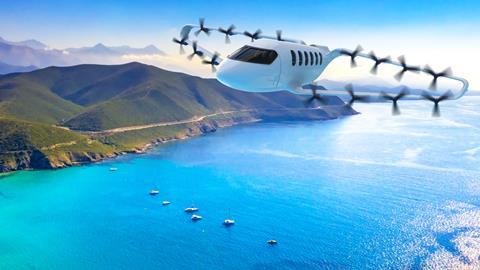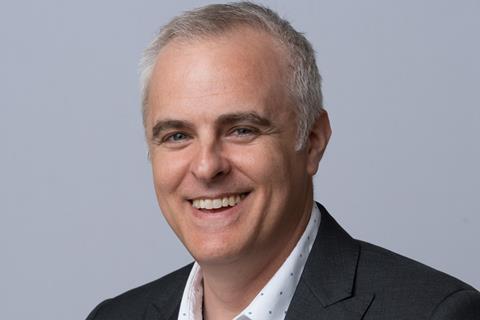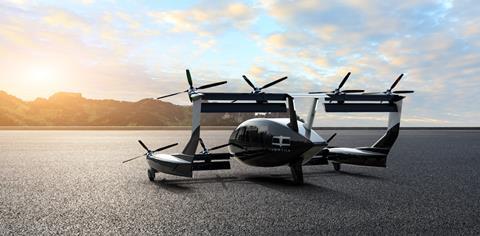Having spent more than a century producing ever-larger aircraft, peaking with the giant Airbus A380, the aerospace sector is increasingly thinking smaller in a very big way.
Urban air mobility is coming, a new phenomenon in which small electric vertical take-off and landing craft – eVTOLs, or air taxis for short – are designed to speed small numbers of passengers over short distances above large, congested cities in a fraction of the time they would take on the ground.

But even before the first of these machines, which look like fattened drones, are approved to commence commercial services, the business cases for their useful deployment are rapidly changing, reshaping the outlook for this emerging sector.
Potential operators and customers are now defining missions which require much greater payloads and longer flight range than the 108nm (200km) maximum offered by most first-generation air taxis, which are largely powered by electric batteries.
Beyond the first movers among eVTOL makers, like US-based Archer Aviation and Joby Aviation, China’s EHang, or UK-based Vertical Aerospace, all of which are already cementing market niches for themselves, changing expectations are challenging the futures of many of the estimated 250 concepts which remain.
Joby and Archer, the clear market leaders, plan to launch their respective models as early as next year in the United Arab Emirates, which is providing solid funding to support its intense desire to be seen as the world’s first regular operator of air taxis, while EHang is expediting a suite of autonomous eVTOL craft.
And aircraft lessor Avolon, which has orders for 500 VX4s from Vertical – in which it is also a shareholder – says its five “target operators,” Japan Airlines, Brazil’s Gol, AirAsia, Air Greenland, and Turkey’s Gözen Holdings, owner of Freebird Airlines – are following the manufacturer’s schedule for entry into service, assuming UK certification late in 2026.
“We are now seeing operators and manufacturers prioritising use cases where demand is higher and entry into service will be smooth,” says Marc Tembleque, Avolon’s senior vice-president, portfolio strategy, identifying Japan and Brazil as two of the leading markets.
“While there may be less headlines today than in previous years, there is more work going on than ever on executing viable applications, which is what the industry needs.”
Several years after a flood of big announcements trumpeting highly conditional plans to acquire vast numbers of eVTOLs, the market is increasingly arguing that without evolution, their restricted performance will also restrict their futures.
“People are realising that the limitation of aircraft battery life is going to be an issue,” says Clem Newton-Brown, chief executive of Skyportz, an Australian start-up focused on infrastructure to support urban and regional air mobility.
“The fully electric models will be suitable for the original idea of intra-city short hops,” he says, though that is mainly in major global cities with big populations where traffic gridlock is large and long-lasting, or for short, sharp tasks such as sightseeing.
“Here in Australia, for example, there’s not really the utility for Jetson-style hopping between buildings. We’re not congested enough for that,” he says.
POLICY SUPPORT
“In capital cities we are preparing for a small number of vertiports to access downtown areas, with an emphasis on waterfront sites. But we don’t expect to see people crossing the city in a short hop.
“Policy support is moving towards regional connectivity. These vertiports will provide access to cities for aircraft that have travelled much longer distances.”
The German government recently illustrated that very point, hesitating to provide additional funding to two high-profile eVTOL developers: Volocopter and Lilium, while backing two new hydrogen-powered regional aircraft programmes.
Angelo Collins is executive director of the Vertical Flight Society (VFS), the only international technical group for engineers, scientists and others working to advance the sector.
It was launched in 1943 as the American Helicopter Society, but as VFS it is expanding exponentially as air taxis prepare to take off.
The key to success, he says, is not just developing new aircraft, but developing machines which efficiently, safely, and viably address clear needs.
While eVTOLs are new, Collins says the concept is not, and points to a little-known US excursion into inner city flights almost 90 years ago.
In 1937, as road traffic congestion increasingly delayed mail deliveries in major American cities, the US Post Office Department began testing autogyros to fly letters between post offices and customers.
For a decade, the post office fleet flitted between rooftops in cities including Chicago, New Orleans, and Washington DC, before the service was permanently withdrawn.
“It never went anywhere because they worked out that no-one really needed the mail to show up within 30 minutes,” says Collins. “It’s all about the value proposition. What am I transporting? Why does the flight time matter?
“We’re still in the first generation of electric VTOLS. I do see promise in the Middle East and China, as they’re not as profit-driven in the near term and more willing to eat some early losses.
“Revenues will be high, but I venture we may not see profitability until the second or possibly third generation of eVTOLs.”
More than 1,000 air taxi concepts have been proposed, with around 250 still estimated to be active. Of these, a handful are edging towards commercial service by late 2025 or 2026, with Joby having just completed pre-production test flights, and Archer preparing for piloted trials.
HIGHER LOAD
But the next generation of VTOL start-ups is rapidly approaching and adopting hybrid propulsion systems to deliver substantially more range or carrying capacity.
“Operators are telling us that payload is hugely important to commercialise eVTOL,” says Avolon’s Tembleque. “There is a higher revenue opportunity in flying an extra passenger or more bags than flying them 20 miles further.
“Designing for higher payload allowance today will enable converting the extra aircraft weight to more range tomorrow as future cell chemistries deliver higher energy density. We anticipate payload and speed capabilities will become a significant differentiator across vehicles.”
Among the new generation of hybrids is Odys Aviation from Long Beach, California, which, as the home of the former McDonnell Douglas Aircraft, is rich in aerospace heritage.
The signature craft for Odys will be the Alta, a nine-passenger, two-pilot design with a box wing and 16 propellers powered by a hybrid-electric powertrain.
Flight range is expected to reach 650nm (1,210km) propelled by dual energy sources – up to 170nm of all-electric propulsion, and up to 480nm more with sustainable aviation fuel, at speeds of up to 300kt (555km/h), and altitudes up to 30,000ft.
James Dorris, the company’s founder and chief executive, wants to provide regional connectivity between major population centres, while improving the air travel experience with a spacious cabin and room for both checked and cabin luggage.

“The biggest untapped market is not how to fly someone from Boise, Idaho, to Bend, Oregon,” he says, “though I’m sure there are those who want to do that. The biggest untapped market is more Los Angeles to San Francisco. For every one person flying that route, there are four driving it.”
Dorris says a flight between Los Angeles and San Francisco is not necessarily between the hub airports of LAX and SFO, as both cities also have, or are close to, multiple other airports, including provincial facilities, and he expects they will eventually have well-located vertiports.
“We’re talking Santa Monica to Fisherman’s Wharf, or Palo Alto to Pasadena, or airline feeder flights from The Hamptons to Newark. That use case exists.
“We want to access people as close as possible to where they’re starting out to reduce or eliminate the time and cost of the Uber ride to or from the airport.”
Some of the most compelling new hybrid VTOL missions won’t carry either passengers or pilots.
In Australia, summer bushfires are endemic, fierce and often inaccessible by road. In recent years, multiple air tankers have crashed while dumping fire retardant, among them a Boeing 737, and a Lockheed Martin C-130 whose three crew were killed.
Sydney-based company AMSL Aero (the initials of its co-founders, Andrew Moore and Siobhan Lyndon) recently secured federal government funding to help develop an autonomous VTOL firefighting aircraft.
It will be based on the company’s Vertiia prototype, an eight-motor, lightweight, box-wing design, with a hydrogen-electric powertrain capable of delivering up to 540nm of range at speeds of up to 160kt.

“Climate change is increasing global demand for aerial firefighting,” says Moore, who is also the company’s chief engineer. “Although aerial firefighting is effective, high human costs and the current limit of daylight operating are significant drawbacks.
“Congested airspace, reduced visibility around fires, and the use of older aircraft create hazardous operating conditions. So we will develop a version of Vertiia that enables Rural Fire Service crews to prevent and put out fires remotely, using swarms of autonomous aircraft like high-tech flying bucket brigades that can operate day and night.
“And because Vertiia is long range and zero emission, it gives us the ability to stay on task longer and means we are not contributing to the climate change problems that are leading to more fires.”
AMSL has already received initial orders for up to 20 piloted aircraft to operate passenger, freight and air ambulance flights.
But chief executive Max York says the company has no immediate plans for urban air mobility.
“In Australia, there are massively under-served regional markets. There are 28 cities with 30,000 people or more, of which 15 locations are served by regular scheduled flights and 13 are not.”
Additionally, he says, many regional communities are not linked to each other, markets he says the Vertiia can easily connect.
“We don’t use the term ‘air taxi’ at all,” says York. “The urban air mobility market is a very difficult nut to crack. We think it will come much later. But when it evolves, we’ll be in the box seat to support it.”
John Langford is chair and chief executive of yet another start-up, US-based Electra, which is pioneering a nine-passenger, hybrid-electric, ultra-short take-off and landing (eSTOL) aircraft, a fixed-wing aircraft with up to 435nm range.
In this constantly evolving era of zero-emission aircraft, that is not a surprising development. But it is when you consider that Langford has deep history in eVTOL development and helped pioneer the genre before giving up on it.
In 1989, he founded Aurora Flight Sciences, which focused on developing autonomous aircraft including electric and hybrid VTOLs for global climate change research. He sold Aurora to Boeing in 2017 but continued to explore commercialising short-range aircraft including eVTOL variants.
“We built and flew more eVTOLs than anyone else on the planet – five or six of them at Aurora,” says Langford. “We were optimistic about eVTOL technology, but the more of it we did, the less optimistic we became.
“Vertical lift is a very expensive from an energy point of view, and batteries just can’t provide useful range. We questioned if you really needed vertical capability for regional routes. In the US, it’s hard to build new airports, so we wanted to fly practical regional ranges, but still be runway-independent without building a VTOL.”
INDUSTRY FOCUS
Langford acknowledges the industry’s focus on decarbonisation and commitment to sustainable aviation fuel but says that’s not enough.
“I think we have to be very vigorous about pursuing alternatives. I’m very bullish on hybrid electric. We have an eSTOL aircraft that is built on a combination of physics and experience, and I think we’ll be proved right in time.”
While the early eVTOL makers progress towards certification, IBA, a UK-based global aviation consultancy, estimates it could take up to five years for others to secure approvals to fly, a lengthy process which could quickly consume remaining capital in an investment market which has become increasingly risk averse.
IBA also expects significant delays in key associated areas including vertiport construction, energy supply and airspace management for urban operations. And that’s without addressing the separate but just as complex question of community approval.
Air taxi routes are short, but their flightpaths to broader deployment, and even survival, seem to be getting longer.


























